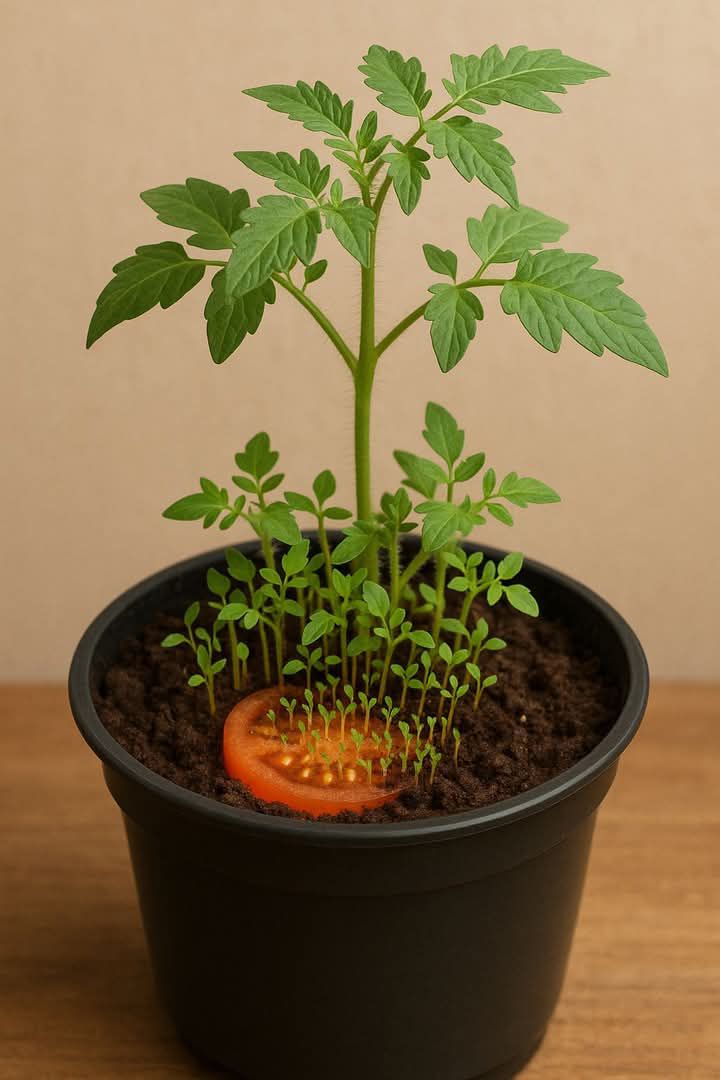1. Why Tomato Slice Propagation Works
Tomatoes reproduce via seeds embedded in the fruit’s gel matrix. Slice propagation leverages this natural seed dispersal mechanism. When slices rest on moist soil, seeds germinate in place, and the pulp provides immediate nutrients. Key factors include:
- Moisture: Keeps seeds hydrated for germination.
- Heat: Warmth accelerates germination timelines.
- Pulp: Contains sugars and organic compounds that feed emerging seedlings.
2. What You’ll Need
- One ripe, firm tomato (avoid overripe to minimize mold risk).
- Quality potting soil or seed-starting mix.
- Small pots, seed trays, or recycled containers with drainage holes.
- Spray bottle or watering can with fine rose.
- Clear plastic dome or plastic wrap (optional for humidity control).
- Labels and waterproof marker for tracking dates and varieties.
Optional: Heating mat to maintain consistent bottom heat (70–85°F) and speed germination.
3. Preparing Your Tomato Slices
- Wash Fruit: Rinse tomato under running water to remove contaminants.
- Slice Thickness: Cut 1/4-inch thick slices to balance exposure and water retention.
- Keep Seeds Intact: Ensure each slice shows visible seeds and pulp layer.
- Label Slices: Write date and variety on container edge for accurate tracking.
4. Planting the Slices
- Soil Moisture: Pre-moisten soil until it’s damp but not waterlogged.
- Slice Placement: Lay slices flat on the soil surface, spacing 1–2 inches apart.
- Light Coverage: Gently sprinkle a thin layer (1/8–1/4 inch) of soil over slices to hide them while allowing light for photosynthetic remnants in the pulp.
- Optional Dome: Cover tray with a clear dome or plastic wrap to retain humidity.
5. Initial Care & Environment
- Temperature: Maintain 70–85°F; use a heat mat if needed.
- Light: Place in bright, indirect light. Avoid direct midday sun on seedlings under domes.
- Humidity: Keep cover in place until sprouts emerge, then remove to prevent fungal issues.
- Watering: Mist soil daily to maintain even moisture; avoid heavy watering that displaces slices.
6. Watching for Sprouts
- Radicles: Tiny roots breaking through soil.
- Cotyledons: First seed leaves emerging above soil.
7. Thinning & Selecting the Best Seedlings
- Identify Vigorous Seedlings: Look for strong stems, healthy green color, and no deformities.
- Thin Out: Snip weaker seedlings at soil level using clean scissors to avoid disturbing roots.
- Maintain Spacing: Aim for 2–3 inches between remaining seedlings.
8. Transplanting Seedlings
- Prepare Pots/Garden Beds: Use well-draining, nutrient-rich soil mixed with compost.
- Harden Off: Gradually expose to outdoor conditions over 7 days—start with 1–2 hours of morning sun.
- Plant Depth: Bury up to first true leaves to encourage strong root systems.
- Water In: Water thoroughly, then apply mulch to conserve moisture.
9. Ongoing Plant Care
- Watering: Provide 1–1.5 inches per week; use drip irrigation if possible.
- Fertilization: Side-dress with balanced fertilizer (NPK 10-10-10) every 4 weeks.
- Support: Stake or cage plants early to prevent damage.
- Pruning: Remove lower leaves 6 inches from ground and suckers on indeterminate types every 2 weeks.
- Pest Monitoring: Inspect weekly; treat issues early with organic sprays or beneficial insects.
10. Delicious Tomato Recipes
- Classic Tomato Bruschetta – a simple, flavorful appetizer showcasing fresh tomatoes.
- Heirloom Tomato Salad – vibrant slices dressed with balsamic and basil.
- Fresh Tomato Sauce – perfect for pasta, pizza, and more.
- Caprese Skewers – cherry tomatoes, mozzarella, and basil on a stick.
11. Troubleshooting Common Issues
Slow Germination
- Ensure temperature is within 70–85°F.
- Maintain consistent moisture; avoid waterlogging or drying out.
Fungal Growth on Slices
- Remove dome for better airflow.
- Use a fungicidal drench of baking soda spray.
Leggy Seedlings
- Increase light intensity or bring closer to a grow light.
- Maintain cool nights (65–70°F) to encourage sturdy stems.
12. Companion Planting & Garden Integration
- Basil: Enhances flavor and repels hornworms.
- Marigolds: Deter nematodes and attract pollinators.
- Onions/Chives: Mask tomato scent from pests.
13. Harvesting & Enjoying Your Tomatoes
- Gently Twist: Avoid pulling vines to prevent damage.
- Store: Room temperature for best flavor; refrigerate only if overripe.
- Use Quickly: Fresh, vine-ripened tomatoes last 3–5 days at room temperature.
Frequently Asked Questions
Q1: Can I propagate any tomato variety this way?
A: Yes—both hybrids and heirlooms work; germination rates vary slightly by variety.
Q2: Will seedlings be true to parent?
A: Seeds from hybrids may not breed true; heirloom seeds will.
Q3: Can I store leftover slices in the fridge and plant later?
A: Better to use fresh slices within 24 hours to maintain seed viability.
Q4: How do I prevent overlapping roots when transplanting?
A: Loosen root ball gently and spread roots slightly in new hole, avoiding circling roots.
Q5: How do I document my time-lapse?
A: Use a fixed camera position, consistent lighting, and capture images every 30–60 minutes.
